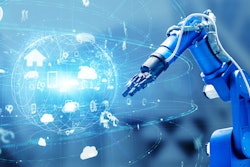
Statista predicts the global artificial intelligence (AI) market will skyrocket to $2 trillion by 2030, up from about $200 billion in 2023. Experts often discuss this massive growth in terms of highly technical industries like manufacturing, healthcare and financial services, which stand to benefit significantly from the operational benefits of AI and machine learning (ML). But what about the restaurant industry?
Perhaps it’s surprising to learn, but AI is experiencing explosive growth in the restaurant, food and beverage industry. In fact, AI is being adopted at a higher-than-average level. According to Mordor Intelligence, AI in the food and beverage industry is anticipated to grow at a CAGR of 38.30% until 2028, compared to 32.9% across all other sectors.
Over the last two years, the restaurant industry has struggled with challenging macroeconomic conditions, including inflation, supply chain issues and labor shortages. Now, AI, ML and automation are overwhelmingly addressing these issues in innovative ways. Let’s discuss how the restaurant industry can employ AI to improve the bottom line today.
AI as a tool for workforce management
According to the National Restaurant Association, more than half of full-service and limited-service restaurants (63% and 61%, respectively) still operate with less staff than necessary to accommodate guest needs. Month-over-month data also indicates that job growth has declined in H2 2023. Bureau of Labor Statistics data suggests that restaurants lost 7,500 jobs in October on a seasonally adjusted basis — a reversal of positive outlooks for job growth in H1 2023.
Most industries are experiencing a labor crunch, but the restaurant sector has had a particularly difficult time filling positions post-pandemic. Many workers found jobs in different industries following the temporary closure of brick-and-mortar locations. Even now, worker retention remains a major stumbling block for some restaurants.
AI can alleviate many of the challenges associated with maintaining and rewarding a restaurant’s workforce.
For starters, AI-powered, self-servicing scheduling systems can automate shift cancelations and requests — a complex and arguably non-intuitive process. Instead of requiring employees to manually identify and message co-workers who may be eligible to take their shift, these systems automatically match strong contenders based on previous working hours and experience. This function streamlines scheduling for both employees and managers.
Furthermore, when adopted across a series of locations, AI systems provide critical insights into operational inefficiencies. ML algorithms minimize labor downtime and maximize productivity with flexible labor forecasting. Managers never have to estimate optimal staffing levels again. Instead, they can rely on their data system to suggest how many employees to staff based on historical data, including average occupancy levels, budget and other desired factors.
Navigating supply chain disruptions with ML
Supply chain operations have improved significantly this year, yet parts shortages, delayed timelines and price hikes remain rampant. Rising food costs are a primary concern among restauranteurs. Downstream pricing — including the uptick in oil and fertilizer prices — has forced many restaurants to exceed their inventory budget just to meet demand.
AI enables a dynamic approach to supply chain management. By understanding their location’s particular fluctuations in demand, managers can alter ordering patterns to ensure they always have enough inventory, but never enough to incur food waste. That’s critical given that restaurants generate 11.4 tons of food waste yearly, resulting in about $25 million in losses.
In addition to curbing food waste, AI unlocks heightened supply chain visibility. AI-backed inventory management systems provide real-time inventory tracking and enable leaders to pivot to alternative suppliers should delays or other disruptions occur.
Automated inventory control and supervision
On average, food costs account for 28% to 32% of a restaurant’s margins, so maintaining an intelligent inventory system is essential.
However, once inventory hits the restaurant floor — or the storage area, to be precise — managers may still struggle to account for and store inventory efficiently. AI can assist by providing automated inventory management, cross-location master data lists, dynamic food costing and menu engineering.
Verifying stock levels is a tedious but necessary task. AI systems can reduce the hassle with easy-to-use inventory management modules. Employees working out of these modules can significantly reduce the time they spend counting inventory each day — freeing up time to spend with customers, behind the counter or in the kitchen. Additionally, AI systems can automatically flag when foodstuffs are nearing expiration, enabling restaurants to maximize their sitting inventory with daily specials or other cost-friendly initiatives.
AI-managed stock monitoring also simplifies the reordering process with automatic order reminders. By replenishing stock to pre-approved levels, these systems simultaneously avoid waste and maintain constant inventory levels, improving customer satisfaction and avoiding disappointment if popular items sell out.
The future of AI, ML and automation for restaurants
By adopting intelligent systems to manage their workforce, supply chain and inventory, food and beverage industry leaders can navigate today’s top challenges. Early adopters, in particular, stand to gain from these technologies, which provide opportunities for boosted efficiency and cost savings up and down the supply chain.
Conversely, restaurants that fail to embrace AI may struggle to keep up operationally and financially. The next half-decade will reveal whether AI in restaurants remains an option or becomes necessary to succeed in an increasingly technology-driven and cost-competitive industry.

















